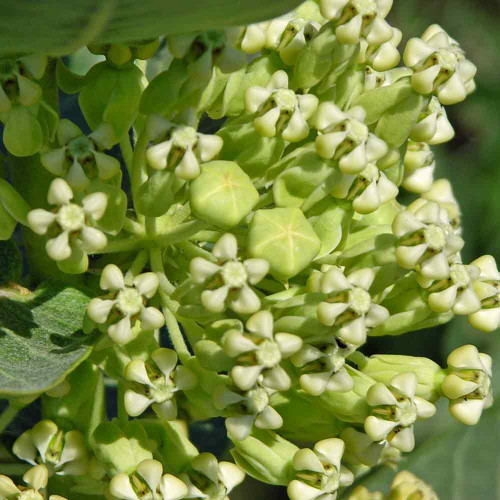Description
Arizona Milkweed - Continuous Blooms from Spring Through Fall
Long overlooked in its native canyons, Arizona Milkweed (Asclepias angustifolia) has now taken center stage in the conservation movement. Today, it works overtime in our gardens, producing a nearly continuous supply of delicate white flowers from spring through fall and creating a reliable habitat for Monarch and Queen butterflies, along with a whole community of native pollinators. It is the perfect choice for the thoughtful gardener who wants to provide a rich habitat without sacrificing order and design.
Details
This resilient wildflower is a perennial native that solves the most common challenge of growing milkweed: its aggressive nature. Unlike many of its relatives, this is a "well-behaved" milkweed, forming a polite, upright clump that will not spread aggressively by underground runners. The plant typically reaches a height of 2 to 3 feet, with a dense cluster of narrow, graceful green leaves that have been compared to Bluestar (Amsonia). From late spring through fall, it produces a continuous succession of delicate, star-shaped white flowers, often with a subtle pink or lavender-tinged center, offering a reliable source of nectar for months on end. In the low desert (Zones 9-10), it can remain evergreen through the winter, with its foliage taking on an attractive purplish hue in the cold.
Following successful pollination, the plant develops its fruit—a slender, upright seed pod typically 1.5 to 3.5 inches long. In late summer or fall, the mature pods dry, turn brown, and split open along a single seam. This releases dozens of flat, brown seeds, each attached to a tuft of silky white hairs called floss, which catches the wind, carrying the seeds away for dispersal.
Planting Arizona Milkweed helps cultivate a thriving ecosystem in your garden. It is a keystone species for Southwestern pollinators, serving as a vital larval host plant for the caterpillars of both Monarch and Queen butterflies. Its role as a tireless guardian extends far beyond these two famous visitors; its exceptionally long bloom cycle makes it a critical nectar source for a vast community of native bees, wasps, and other butterflies, especially during the lean times of late summer. A key feature is its adaptability to containers; it excels in deep pots, making the benefit of planting milkweed easier for those who garden on balconies and patios. Furthermore, while it develops a deep taproot for drought tolerance, its root system is more fibrous and forgiving than many of its cousins, making it significantly easier to transplant.
History
Long before its scientific classification, milkweed was a cornerstone of life for indigenous peoples in the Southwest, who used its tough stem fibers for cordage and various parts of the plant for food and medicine. The genus was named Asclepias in honor of Asklepios, the Greek god of healing, a nod to this extensive history of medicinal use.
While its roots are firmly in American soil, the full story of Arizona Milkweed begins an ocean away. In 1812, German naturalist August Friedrich Schweigger officially described the species not from a dried specimen, but from a living plant already growing in the Konigsberg Botanical Garden in Prussia. This "debut in exile" means that an unknown explorer recognized its value and transported it to the Old World's sophisticated network of botanical gardens well before the Arizona territory was widely explored. For nearly two centuries, it remained a botanical curiosity until the decline of the Monarch butterfly cast a spotlight on its importance.
Arizona has more than 40 species of milkweed - more than 50% of the total diversity of milkweeds in the continental US - giving it the third greatest diversity of milkweeds next to Texas and California.
Planting and Growing Tips
Reflecting its warmer native climate, Arizona Milkweed does not need the complex cold stratification required by its northern cousins. Successful germination is best achieved with a simpler approach: soak the seeds in warm water for 24 hours just before planting to soften the seed coat. For a deeper dive into the science of waking up milkweed seeds and for expert tips on container selection, please see our complete Milkweed Seed Germination Guide.
Sow seeds no more than 1/8 inch deep in a location that receives full sun to light partial shade. Arizona Milkweed is native to canyons and thrives in coarse, gritty, well-drained soil, making it a perfect choice for rock gardens or xeriscapes. While it requires regular moisture to get established, it is exceptionally drought-tolerant once its taproot is in place.
Will This Grow in My Area?
While native to the American Southwest and northern Mexico, the potential growing range for Arizona Milkweed extends beyond this territory. Success in other regions depends on a simple principle: mimic the plant's preferred native environment. It can be successfully cultivated in any area that offers a similar hot, dry climate with coarse, well-drained soil. Gardeners in the arid inland regions of California, southern Utah, Nevada, and other similar climates will likely find that this variety adapts well.
You can view its documented native distribution on the USDA PLANTS Database Map to compare its native climate with your own.
Harvesting and Seed Saving
As a native perennial, Arizona Milkweed will produce viable seeds, allowing you to participate in its preservation. Slender seed pods form after pollination. The ideal time to harvest is when the pods turn from green to a dry, brownish-tan and just begin to split open along their seams. Carefully snip the pod from the plant. To separate the seeds from the fluffy floss, place the entire contents in a paper bag with a few coins and shake vigorously. The heavier seeds will fall to the bottom. Store the clean, dry seeds in a cool, dark place.
Why This Milkweed is Special
Our Arizona Milkweed seeds are the result of a dedicated, small-scale effort. They are carefully hand-grown, hand-harvested, and hand-cleaned by dedicated growers across central and northern Arizona. To ensure its vigor and adaptability, each variety has been test-grown at different elevations over the past several years.
We are the exclusive partner offering these unique seeds to home gardeners. Proceeds from every sale are shared equally to directly support the ongoing research of the Arizona Milkweeds for Monarchs organization. This dedicated citizen-science group, overseen by professional scientists from Northern Arizona University, is doing the vital on-the-ground work of studying and preserving these essential native plants.
Learn More
- Milkweed Seed Germination Procedures
- Growing Milkweed for the Monarch Butterfly
- Planting A Pollinator Feast
From the soil to the seed to the food you eat - we'll help you grow your best garden!
2 Reviews
-
Great germination
Excellent rate of germ, and this species is quick to flower. If wanting to bulk seed up, put near other pollinator plants and small bees will do the work. Over 7 pods on 2 plants so far, after 3mo from seed!
-
Great seeds!
Thanks for carrying so many types of milkweed for the Monarchs!















